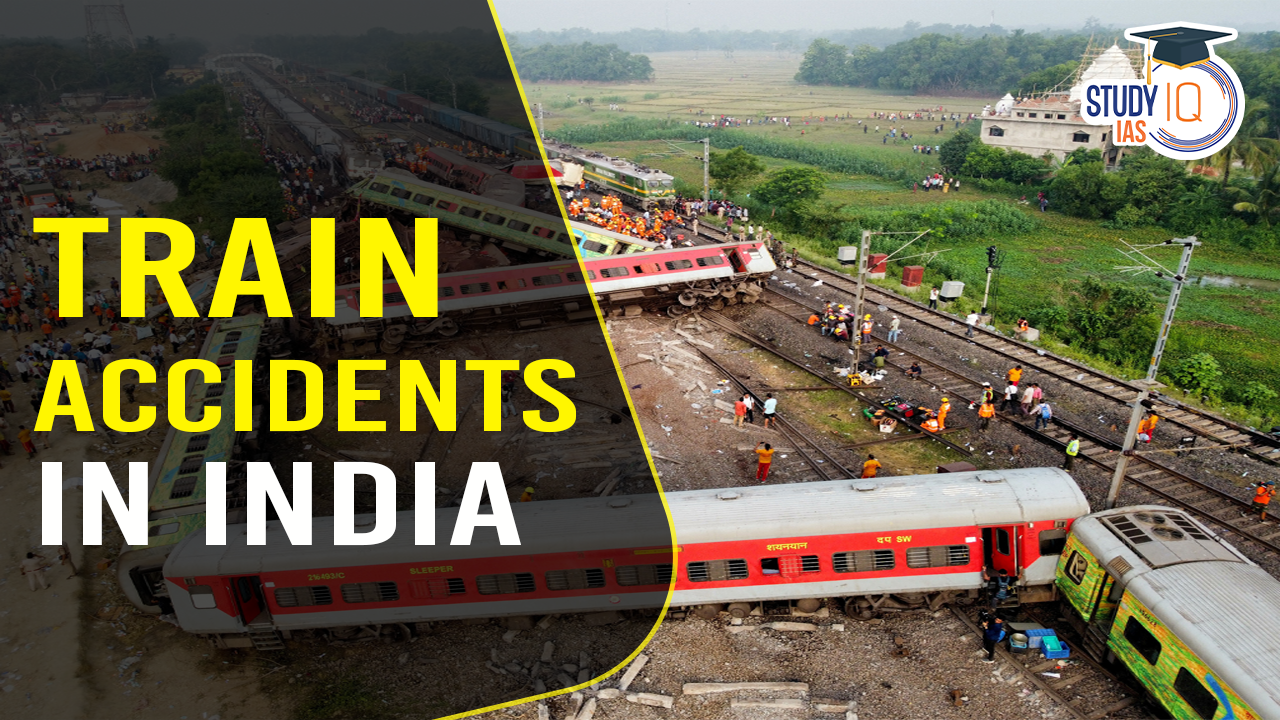Table of Contents
Train accidents in India have been a persistent concern due to various factors ranging from infrastructure challenges to human errors and operational failures. These incidents not only result in loss of lives but also raise questions about safety protocols, maintenance practices, and the overall management of the extensive railway network.
Train Accidents in India
Train accidents in India are often caused by mechanical failures, human errors such as signal failures and overspeeding, infrastructure deficiencies like poorly maintained tracks, adverse weather conditions, and occasionally, acts of sabotage. Notable incidents include the Gorakhdham Express derailment in 2014 and the Balasore triple-train collision in 2023. Measures to mitigate risks include technological upgrades, enhanced training, infrastructure modernization, and regulatory reforms to ensure safer railway operations nationwide.
Kanchanjunga Express Collision 2024
- Date: June 17, 2024
- Location: Near Rangapani railway station, West Bengal
- Casualties: 9 killed, 25 injured
- Details: A collision between Kanchanjunga Express and a goods train resulted in derailment and casualties. The cause is under investigation, highlighting ongoing safety challenges despite previous incidents prompting scrutiny.
Causes of Train Accidents in India
Train accidents in India can be attributed to several factors:
- Mechanical Failures: Such as defects in locomotives, brake failures, or axle issues leading to derailments.
- Human Errors: Including errors in signaling, improper switching of tracks, or train operation mistakes.
- Infrastructure Issues: Poor maintenance of tracks, bridges, and other infrastructure components that can lead to accidents.
- Weather Conditions: Adverse weather like heavy rains, fog, or extreme temperatures affecting visibility or track conditions.
- Sabotage: Deliberate acts of sabotage or vandalism on railway tracks or infrastructure.
Recent Train Accidents in India
In the past decade, several major train accidents have occurred in India, highlighting persistent safety concerns within the railway network:
| Year | Train Accident | Location | Cause | Casualties |
|---|---|---|---|---|
| 2014 | Gorakhdham Express | Chureb, Uttar Pradesh | Fracture in track (Failure of Equipment) | Multiple fatalities and injuries |
| 2015 | Janata Express | Bachhrawan, Uttar Pradesh | Signal overshoot, braking failure | Significant casualties |
| 2016 | Indore-Patna Express | Pukhrayan, Kanpur Dehat district | Mechanical failure initially suspected as sabotage | 152 fatalities |
| 2017 | Hirakhand Express | Kuneru, Andhra Pradesh | Derailment, suspected explosive sabotage ruled out | Fatalities and injuries |
| 2018 | Amritsar Train Tragedy | Amritsar, Punjab | Ran over Dussehra celebrants on tracks | Over 60 casualties |
| 2019 | Seemanchal Express | Vaishali, Bihar | Rail fracture due to maintenance issues | Deaths and injuries |
| 2020 | Aurangabad Migrant Workers Tragedy | Maharashtra | Workers sleeping on tracks struck by train | 16 fatalities due to exhaustion |
| 2022 | Bikaner-Guwahati Express | Jalpaiguri, West Bengal | Equipment failure (Failure of Equipment) | Fatalities and injuries |
| 2023 | Balasore Triple-Train Collision | Balasore, Odisha | Multiple train collision due to operational lapses | High death toll, extensive investigations |
Prevention of Train Accidents in India
Preventing train accidents in India requires a comprehensive approach addressing various factors contributing to such incidents. Here are key strategies and measures that can help mitigate the risks:
- Infrastructure Modernization:
- Upgrade and maintain railway tracks, bridges, and signaling systems to ensure they meet safety standards.
- Implement advanced technologies like automatic signaling, train protection warning systems, and anti-collision devices.
- Maintenance and Inspection:
- Regularly inspect and maintain rolling stock (trains), tracks, and other railway infrastructure to prevent mechanical failures.
- Conduct thorough checks for wear and tear, corrosion, and other potential hazards.
- Safety Protocols and Training:
- Train railway personnel, including drivers, signalmen, and maintenance staff, on safety procedures and emergency response.
- Enforce strict adherence to operating procedures, speed limits, and signaling protocols.
- Technological Advancements:
- Introduce and utilize advanced technologies such as GPS-based train tracking and communication systems to enhance operational safety.
- Implement predictive maintenance systems to detect potential failures before they cause accidents.
- Public Awareness and Education:
- Educate passengers and the public about safety measures and the dangers of trespassing on railway tracks.
- Promote awareness campaigns on railway safety and responsible behavior near railway lines and stations.
- Emergency Response and Preparedness:
- Ensure swift and effective emergency response capabilities, including medical assistance and rescue operations.
- Conduct regular drills and simulations to prepare railway staff and emergency responders for various accident scenarios.
- Regulatory Oversight and Accountability:
- Strengthen regulatory frameworks to enforce safety standards and protocols across the railway network.
- Hold accountable those responsible for safety lapses or negligence leading to accidents.
- Collaboration and Information Sharing:
- Foster collaboration between railway authorities, government agencies, and industry stakeholders to share best practices and lessons learned.
- Establish mechanisms for continuous improvement based on data analysis and incident investigations.


 UDAN Scheme, Objectives, Funding and Ach...
UDAN Scheme, Objectives, Funding and Ach...
 Indus Water Treaty 1960 Suspended by Ind...
Indus Water Treaty 1960 Suspended by Ind...
 5 Years of SVAMITVA Scheme and Its Benef...
5 Years of SVAMITVA Scheme and Its Benef...





















